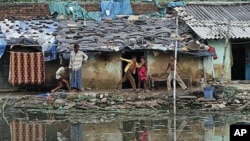The Indian government will not limit social benefits only to those who make less than 50 cents a day in villages and 66 cents a day in cities, which many had feared would be the result of a controversial poverty benchmark proposed last month. The new poverty line triggered an outcry and raised concerns that millions of poor people would be excluded from government welfare programs.
Rural Development Minister Jairam Ramesh said Monday that beneficiaries of federal welfare programs targeted at the poor will not be restricted by the poverty line set by the planning commission. He called it a significant development.
“The Planning Commission and the Ministry of Rural Development will now work out an agreed methodology with which the states are also comfortable, which will ensure that once the households are ranked according to deprivation, the selection takes place in a manner that no poor and deprived household is excluded from the purview of central government programs," said Ramesh. "This is a major step forward.”
The announcement was made following a massive outcry over the norms on poverty set by the planning commission. The commission had said that people who spend more than half a dollar a day on food, education and health in rural areas and 66 cents a day in urban areas are not poor. That is about half the World Bank’s poverty line of $1.25 a day.
Activists, several economists and opposition members cried foul. They said that the threshold set was not even at subsistence level and left out millions who should be counted among the poor.
The norms embarrassed the government, and were even criticized by some members of the ruling Congress Party. Activists accused the government of trying to reduce the number of beneficiaries of the ambitious social welfare programs it has announced.
Planning Commission Deputy Chairman Montek Singh Ahluwalia agreed that the norms were set at a low level.
“It is clearly a rock bottom level of existence and we know very well that everybody at that level of existence is under significant stress. In fact, we know that even above that level, households are vulnerable,” said Ahluwalia.
Ahluwalia clarified that the norms had been based on the assumption that health and education would be provided free of cost to the poor. He said that has not happened in many states across the country.
“In my view, it is a shame that the public service system for health and education has not delivered these services. In my view, the solution is spend more money on health, spend more money on education,” said Ahluwalia.
The Planning Commission says poverty levels in the country have fallen over the past decade as the economy expands. But the numbers are still huge: About one third of India’s population - or roughly 400 million people - are estimated to be poor.
India Rethinks Poverty Benchmark












